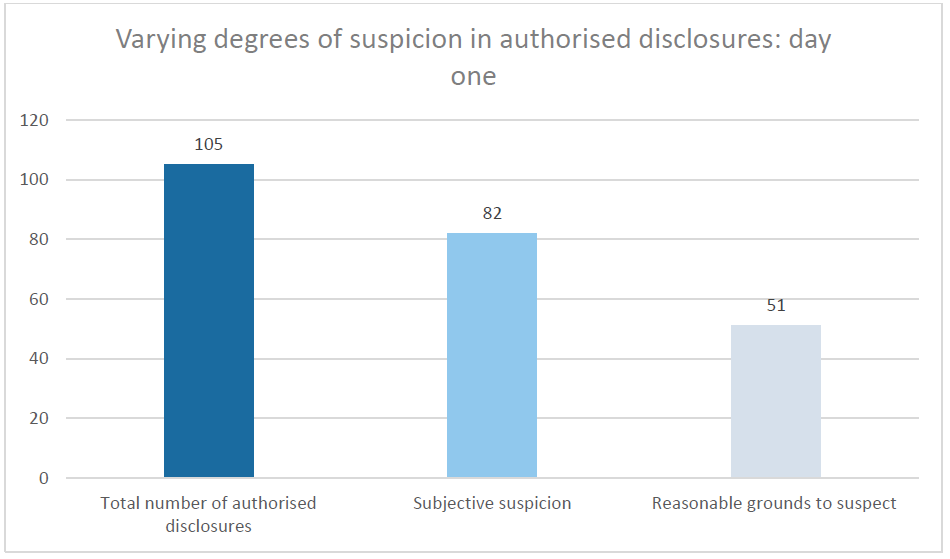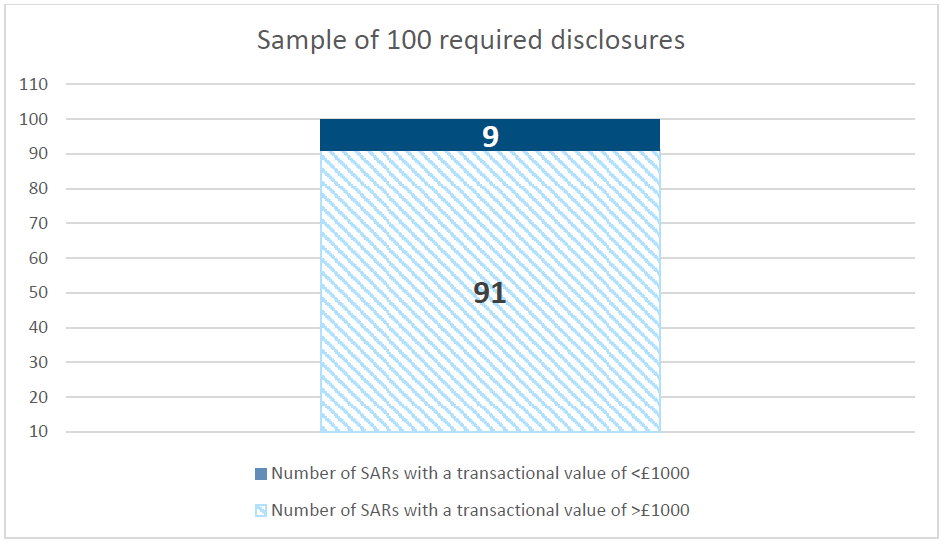2.22 We analyse the findings of our research in each subsequent chapter as relevant. However, we make some general observations at this stage:
(1) There was substantial variance in the quality of disclosures. At one end of the spectrum SARs were unnecessarily long and contained irrelevant information which diverted the reader from identifying the essential information in the report. Other reports were incredibly brief and omitted essential information. There was clear evidence of reporters misunderstanding their legal obligations under Part 7 of the Proceeds of Crime Act 2002 («POCA»).
(2) Of particular concern was the inconsistent application of the concept of suspicion by reporters. The suggestion in our Consultation Paper that this was a weakness in the regime was borne out in our analysis:
(a) suspicion which met the Da Silva test was not present in 15% of the authorised disclosures that we analysed and 13% of required disclosures;
(b) reasonable grounds to suspect was present in approximately 53% of the authorised disclosures that we analysed and only 32% of required disclosures.
2.23 The chart below provides a snapshot of the application of suspicion in our sample of authorised disclosures. The results are taken from the first day of the data analysis exercise. Reporters failed to provide evidence of their suspicion in more cases on the first day of the data analysis exercise than on any other day of the analysis. In 78% of cases reporters demonstrated evidence of a suspicion of criminal property. In 22% of cases reporters failed to show that their suspicion met the Da Silva test. Reporters provided one or more objective grounds in support of their suspicion in 49% of the SARs that we analysed.

2.24 Other general observations to note are:
(1) where the predicate offence was identified, the overwhelming majority of authorised disclosures were related to serious crimes using our qualifying criteria for that concept. In approximately 64% of the SARS we analysed reporters had identified predicate offences. Of those SARs, approximately 98% qualify as a serious crime;
(2) approximately 22% of the authorised disclosures we analysed were lodged in respect of suspected criminal property which amounted to less than £1000 in value. In relation to required disclosures, the chart below illustrates that figure was much lower at only 9%.

Conclusion
2.25 We incorporate our findings from this research into our analysis in subsequent chapters. However, the value of the exercise itself merits further consideration. Our analysis has, by focussing on the quality of disclosures and their usefulness to law enforcement agencies, provided real insight into the effectiveness of the consent regime.
2.26 One limitation of our analysis is that we were not able to seek law enforcement agency input on the quality of the SARs we analysed. We believe that analysis of SARs would benefit from such a two-tiered approach to gain the perspective of those who will consider and potentially make use of the information in the SAR.
2.27 Testing the quality of disclosures using a two-tiered approach involving law enforcement agencies could provide essential feedback on:
(1) whether disclosures are made only when necessary, that is required by law or submitted in order to provide the reporter with an exemption from a criminal offence;
(2) whether disclosures provide the right information to assist law enforcement agencies to best effect;
(3) problems or misunderstandings arising within the regime which have an impact on reporters and/or the UKFIU.
(4) the success of any measures intended to reform the regime.
2.28 In addition, ongoing analysis could provide greater clarity on whether the threshold for reporting is set correctly at suspicion or whether it should be changed to reasonable grounds to suspect.
Recommendation
2.29 Given the richness of the data and the overall value that is obtained from analysing a sample of SARs, we recommend that similar analysis should take place at regular intervals on a larger scale. In chapter 3, we recommend the creation of an Advisory Board. We recommend that consideration be given to utilising the experience and expertise of such a Board to develop a robust process of ongoing analysis.
Recommendation 2.
2.30 We recommend that further analysis on the quality of SARs is conducted at regular intervals in consultation with an Advisory Board.
